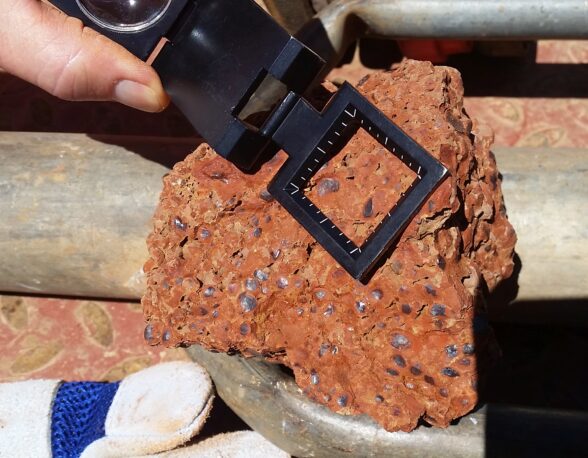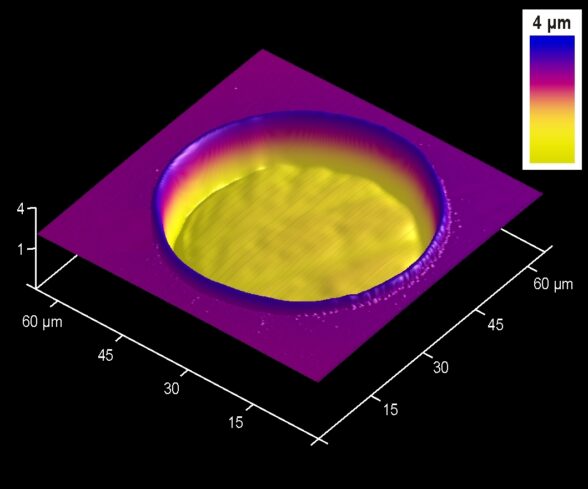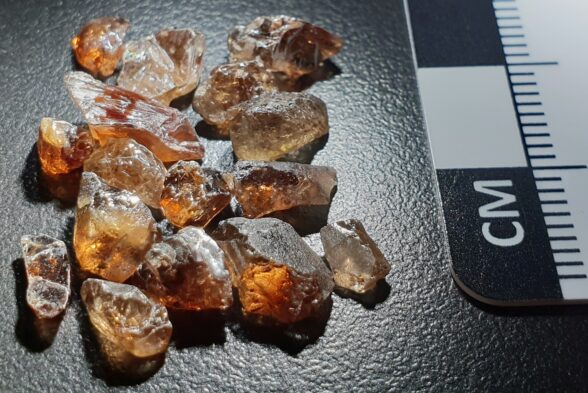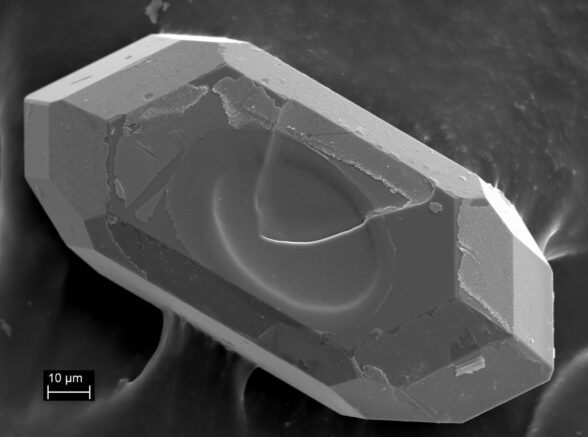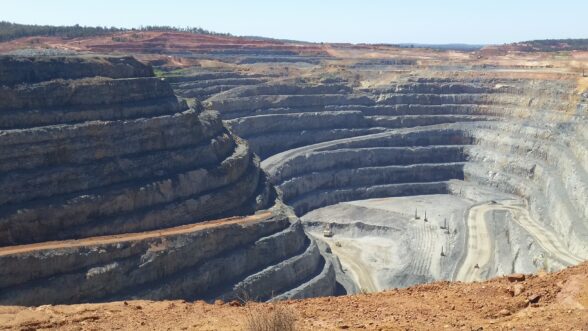Western Australia ThermoChronology Hub Facility
The Western Australia ThermoChronology Hub (WATCH) Facility specializes in geological applications and methodological developments of (U-Th)/He and fission track (FT) dating techniques.
The WATCH facility is fully equipped to conduct a range of analytical approaches, including both conventional (whole grain) and in-situ (U-Th)/He analysis, as well as external detector and laser ablation fission track analysis. These techniques record the low-temperature (<300°C) cooling history of a wide variety of minerals and can address a broad range of questions in the earth sciences (e.g., geodynamics of orogenic systems, evolution of sedimentary basins, the genesis and preservation potential of mineral deposits, weathering geochronology, dating of young volcanic rocks, provenance studies).
Techniques/Capabilities
- conventional (i.e., whole grain) (U-Th)/He dating of U-Th bearing minerals (e.g., apatite, zircon, iron oxides)
- in-situ (U-Th)/He dating using laser ablation
- in-situ 2D helium mapping and 1D helium profiling
- step-heating diffusion experiments
- fission track (FT) analysis of apatite and zircon (and other minerals) using the external detector method or a laser ablation approach
- multi-dating techniques combining Lu-Hf – U-Pb – FT – (U-Th)/He applied to single crystals
Instruments

Alphachron I.
The Alphachron I. is a prototype instrument for automated extraction and measurement of He gas from whole mineral grains, which was jointly developed by the CSIRO Division of Exploration and Mining (DEM) and Patterson Instruments, and is now commercially available as the AlphachronTM. Helium is thermally extracted from minerals using either a diode laser (small volume samples) or tube furnace (large volume samples), and analysed by isotope dilution on a Pfeiffer Prisma QMS 200. It is fitted with a diffusion cell for step-heating experiments.

Alphachron II.
The ASI Alphachron II. is an automated system for extraction and measurement of Helium gas. It is fitted with a diode laser for the degassing of whole mineral grains for conventional (U-Th)/He dating applications. It is also connected to an excimer laser for in- situ Helium extraction by laser ablation, which allows analysis of intra-grain domains and is used for “in-situ” applications (e.g., U-Pb – (U-Th)/He double-dating, He mapping).

RESOlution-SE Excimer Laser
The RESOlution-SE is a 193nm excimer laser ablation system fitted with a Laurin Technic S-155 sample cell for LA-ICPMS applications (U-Pb geochronology, trace element analysis), and with a Laurin Technic UHV cell for in-situ Helium analysis. The system is connected to the Alphachron II. and to an Element XR High Resolution ICPMS.
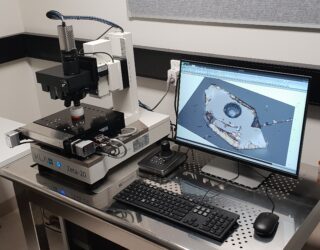
Zeta-20 Optical Profiler
The Zeta-20 Optical Profiler (KLA) is a benchtop optical profiler system for non-contact, 3D surface topography measurements. It has a high vertical resolution (2-13 nm), and the ability to collect data from near-vertical features, which makes this system uniquely suitable for the accurate and precise measurements of ablation pit volumes, a critical step for in-situ (U-Th)/He dating.
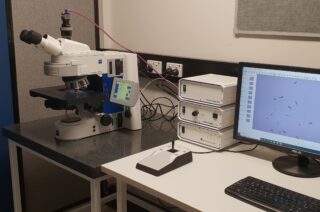
Autoscan Fission Track Counting System
The Autoscan Deluxe Automated Counting System for fission track analysis integrates a Zeiss Axio-Imager Z2m enhanced motorized research microscope with a range of objectives, motorized piezo scanning stage (130×85 mm), and high-resolution (4 Mp) colour digital camera for optimal fission track analysis. Fission Track Studio automated counting software (TrackWorks and FastTracks) is used for data processing.
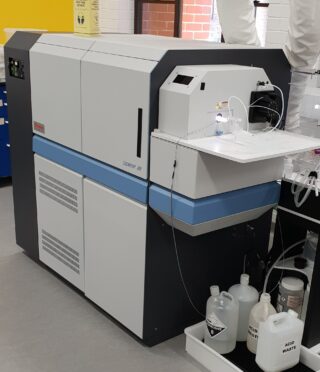
Element XR High Resolution ICP-MS
The facility is co-located with an Element XR ICP-MS instrument (high-resolution, high-sensitivity inductively coupled plasma sector field mass spectrometer) which provides quantitative multi-element analysis of trace and ultra-trace elements over a wide linear dynamic range, from the ppm to the sub-ppb level. This instrument is routinely used to measure U-Th-Sm content in dissolved samples for (U-Th)/He dating and also for laser ablation U-Pb dating.
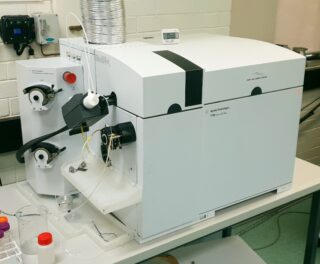
Agilent 7700x ICP-MS
The Agilent 7700x is a quadrupole ICP-MS providing high throughput, matrix tolerance, wide elemental coverage and low limits of detection for elemental and isotopic analysis. This instrument is routinely used to measure U-Th-Sm content in dissolved samples for (U-Th)/He dating or Rhenium isotopes for Re-Os dating. It can be connected to the RESOlution-SE excimer laser ablation system and used for U-Pb dating or in-situ trace element analysis of solid samples.
Applications and representative publications
Exhumation and erosion history of mountain ranges and cratons
- Nie et al. 2018. Rapid incision of the Mekong River in the middle Miocene linked to monsoonal precipitation. Nature Geoscience 11 (12): 944-948.
- Danišík & Kirkland 2023. Thermochronometry constraints on south West Greenland passive continental margin development. Communications Earth & Environment, 4(1), 124
- Li et al. 2023. Late Cretaceous–Cenozoic thermal structure and exhumation of the Eastern Tibetan Plateau margin: A doubly-vergent orogenic wedge. Earth-Science Reviews, 238, p.104319.
(U-Th)/He dating of Fe-oxides and oxyhydroxides (e.g., hematite, goethite, martite) (weathering geochronology, Fe ore genesis)
- Wells et al. 2019. (U-Th)/He-dating of ferruginous duricrust: Insight into laterite formation at Boddington, WA. Chemical Geology 522: 148-161.
- Danišík et al. 2013. (U-Th)/He chronology of the Robe River channel iron deposits, Hamersley Province, Western Australia. Chemical Geology 354: 150-162
- Dröllner et al. 2023. Directly Dating Plio‐Pleistocene Climate Change in the Terrestrial Record. Geophysical Research Letters, 50(8), p.e2023GL102928
Volcanic geochronology in the “critical window” (2,000 yrs – 1 Ma) and beyond using combined U-Th-disequilibrium (or U-Pb) and (U-Th)/He dating of zircon (a.k.a. zircon double-dating)
- Mucek et al. 2017. Post-supereruption recovery at Toba Caldera. Nature Communications 8
- Danišík et al. 2016. Application of combined U-Th-disequilibrium/U-Pb and (U-Th)/He zircon dating to tephrochronology. Quaternary Geochronology
- Schmitt et al. 2014. Identifying the volcanic eruption depicted in a Neolithic painting at Çatalhöyük, Central Anatolia, Turkey. Plos ONE 9 (1)
- Scarrow et al. 2023. Zircon double-dating, trace element and O isotope analysis to decipher late Pleistocene explosive-effusive eruptions from a zoned ocean-island magma system, Ascension Island. Quaternary Science Reviews, 319, p.108304
Tephrochronology
- Danišík et al. 2021. Gigantic eruption of a Carpathian volcano marks the largest Miocene transgression of Eastern Paratethys. Earth and Planetary Science Letters 563
- Danišík et al. 2020. Sub-millennial eruptive recurrence in the silicic Mangaone Subgroup tephra sequence, New Zealand, from Bayesian modelling of zircon double-dating and radiocarbon ages. Quaternary Science Reviews 246
Methodological developments of low-temperature thermochronology techniques (e.g., in situ U-Pb-He double-dating, He mapping, multi-system dating approaches, etc.)
- Danišík et al. 2017. Seeing is believing: Visualization of He distribution in zircon and implications for thermal history reconstruction on single crystals. SCIENCE ADVANCES 3 (2)
- Danišík 2019. Integration of fission track thermochronology with other geochronologic methods on single crystals. In Fission-Track Thermochronology and its Application to Geology, Springer International Publishing.
- Evans et al. 2015. An in situ technique for (U-Th-Sm)/He and U-Pb double dating. Journal of Analytical Atomic Spectrometry 30 (7): 1636-1645.
Full publication record of the WATCH Facility can be found here.
To enquire about the applications, potential collaborations, services and rates, please do not hesitate to contact A/Prof Martin Danišík.

